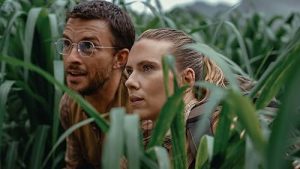The seventh instalment in the Jurassic Park franchise returns to its roots.
After three films where humans went into their environment, the rebooted Jurassic World brought dinosaurs into human-dominated populations.
We then spent two films dealing with what could happen when dinosaurs start getting restless in a big city.
Jurassic World: Rebirth takes us back to the jungle and the franchise is better for it.
Rather than going down the path of becoming a Transformers-type experience, we have reverted to a sprinkle of science, lots of creatures back in a natural environment and almost non-stop chase action.
In a break with the norm, this is also the first instalment that doesn’t include any characters from the previous films and there’s also a new director in Gareth Edwards.
While he hasn’t made a Jurassic film before, Edwards is no stranger to large creatures on screen, having helmed the successful 2014 version of Godzilla which was particularly praised for its ability to portray massive height and weight scale.
By all accounts Edwards wasn’t as involved in the computer-generated imagery and animatronics that went into Jurassic World: Rebirth, but there are certainly still some scenes where the scale involved is well presented, particularly during the stand-out, ocean-based action sequences during the first half.
David Koepp, co-writer of the original film and its sequel, The Lost World: Jurassic Park (1997), returns to add the sprinkle of science that I referenced earlier and it’s enough to provide a believable enough premise.
A short prologue establishes that humans, as is their want, started to experiment on dinosaurs in forlorn hopes of creating hybrids to serve a specific purpose.
We then move to five years after the events of Jurassic World Dominion. Earth’s urban environment is starting to weigh heavily on the remaining dinosaur population and humans have grown tired of their presence.
There is a great scene early on with a character’s car caught in a traffic jam which turns out to have been caused by a huge dinosaur lying down across the freeway, annoying drivers and the crews trying to coax her away.
That character is Martin Krebs, a pharmaceutical company executive played by Rupert Friend, whose company has discovered that blood from mega-dinosaurs could be used to help extend the lives of human patients suffering from heart disease.
But there are a couple of catches. The blood must be drawn from a live specimen and all the mega-dinosaurs are living in a remote location where entry is forbidden under international law.
Scarlett Johansson plays mercenary Zora Bennett who is offered a king’s ransom to take Krebs and palaeontologist Dr Henry Loomis (Jonathan Bailey) into the danger zone. Bennett recruits fellow mercenary Duncan Kincaid (Mahershala Ali) and his team to accompany them.
The action sequences shift between this group and a father, his two daughters and one of their boyfriends, who are on a recreational sailing trip in the area when they attract the attention of a massive, speeding aquatic dinosaur.
This and other action sequences on the water are very well staged with terrific integration with the CGI and realistic stunt work.
Not all the action that follows hangs together as well, e.g. how a dinosaur doesn’t destroy a rubber life raft while playing with it is beyond me and there are one too many very close calls.
But there are also a lot of other positives including decent acting, a variety of chase locations including jungles, rapids, cliffs and tunnels, a score that incorporates the original theme well and, best of all, a multitude of returning and new dinosaur species.
Talk of the franchise running out of steam is greatly exaggerated.
Watched at the cinema.
